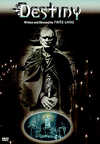Destiny
Image Entertainment
Cast: Lil Dagover, Walter Janssen, Bernhard Goetzke, Rudolph Klein-Rogge
Extras:
Rating:
’Destiny, ’ Fritz Lang’s 1921 meditation on love and death, weaves the tale of a young couple (Lil Dagover and Walter Janssen) en route to their wedding when Death personified (the wonderfully gaunt Bernard Goetzke) takes the young man. Determined to return her love to the living, she ingests a potion that brings her to near-death. Within a mysterious room of candles, one flickering for each human life, Death offers to grant her plea if she can save one of three lives before their light snuffs out. From ancient Persia to Renaissance Venice to a fairy tale China, this eternal couple plays out the separate struggles of other lovers trying to thwart fate.
’Destiny’ presents one haunting image after another: Death sitting down in a tavern, his drink dissolving into an hourglass; a ghostly parade of souls entering Death’s garden; a sorcerer’s gift of a living miniature army to a Chinese emperor. Even Lang’s depiction of Death confounds expectation, woefully bemoaning how humanity scorns him just for ’obeying God’s will.’ One might look at ’Destiny’ as nothing more than an ancient ’Twilight Zone’ episode. Indeed, the liner notes suggest the film is a possible inspiration for such fantasy-omnibus films as ’Dead of Night, ’Tales from the Crypt,’ or even ’Bedazzled, where its plot of a single character placed in different scenarios rings uncannily similar to ’Destiny’s.’
Image Entertainment’s DVD presentation startles as much as the film’s rather modern ruminations on the power of undying love. Given the fidelity of the material, ’Destiny’ looks remarkably vital. Black levels are solid, allowing rather startling shadow definition in some scenes but muddying up details in less intact moments. Wear on the sources is evident throughout the window-boxed transfer. On my projection monitor, the sides were severely masked with the bottom cropped just a sliver. The tinted sequences following traditional guidelines: bluish casts for night scenes, sepia for outdoor moments. The only time the tinting overpowers is during a fire scene, the reds all but blotting out the image.
A newly recorded music score by the Mont Alto Motion Picture Orchestra emphasizes period music arrangements. Complimenting both the narrative and mood well, the soundtrack itself is quite full blooded although its vigor at times contradicts the delicacy of the images.
That ’Destiny’ returns to an audience some 80 years after its initial release is reason alone to celebrate. For fans or students of silent cinema or fantasy films, I highly recommend this early excursion into the dream realm.


